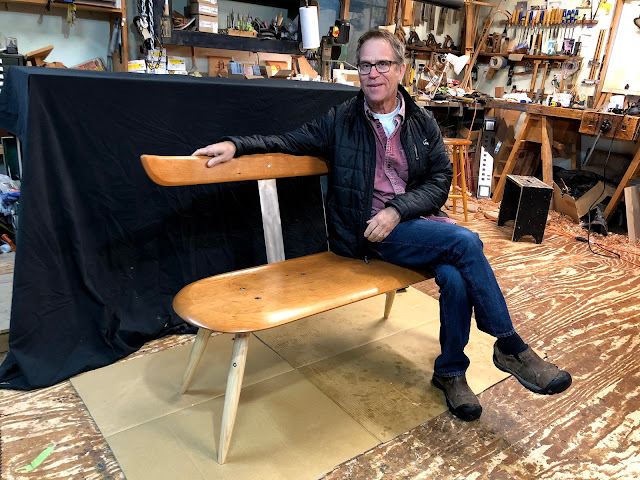My goal for the Hybrid Windsor Bench was to create a bench that ventures beyond Windsor traditions. Made of sculpted parts of warm wood combined with cool clean steel, it would be inviting to the touch and keep the sitter interested in where they are sitting.
Windsor chairs and benches are defined by a solid seat that has legs and back mortised into it. In this piece, I have exchanged the wedged tenon wooden joinery with stainless steel bolts and fittings while the back and leg support structure is swapped for CAD designed parts.
Every new design remains a mystery until it is completed and I am very happy with how this came out. The back has a nice give to it as do the backs of my usual Windsor chairs that have my trademark "Floating Back". This steel supported back is quite flexible in contrast to what may be expected. The wood is warm and inviting to touch. I think that this is the beginning of many new related pieces.
Over the last few years I have taught myself Computer Aided Design or CAD. For this project, I worked up the design for the piece using the CAD software, but more importantly, I was able to create the files that ran the machine which cut out the stainless steel components. I emailed the files to a machine shop in the next town over and the files were used to drive a waterjet cutter to make my parts. Each part is exactly like the next and exactly what I had designed.
The wooden part of the design centers around a seat that is cut from the same pattern as my more traditional Windsor benches and has turned legs that also come from my
previous work. The sculpted crest rail is new but is actually bent over the same jig as my other Windsor benches. See my other benches here.
While the steel is cut out by a computer guided machine, the wooden parts are shaped and sculpted by hand and the steel parts are all ground and polished to create touchable edges. All of the stainless steel bolt fastenings are chosen to create a finished looking surface top and bottom. The hex heads that are visible on the top of the bench are set flush to the surface. In my mind, these are similar to the look of a traditional, wooden, through wedged tenon joint. As in Shaker tradition, joints are not hidden but are celebrated whether they be metal or wood.

Below is the sketch that led to this design.
Enjoy the fall weather!
Tim









